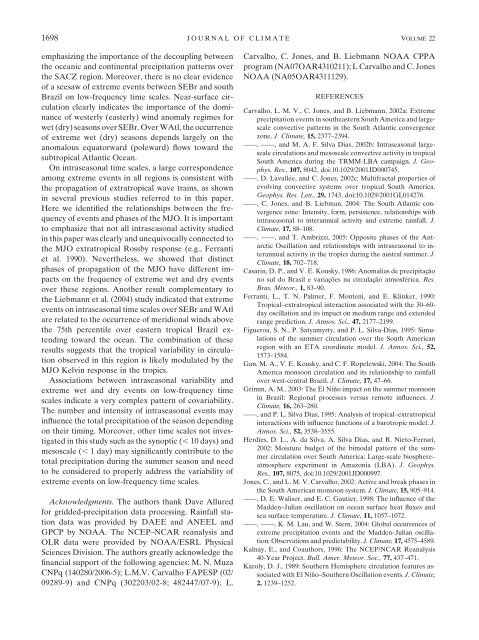Arquivo do Trabalho - IAG - USP
Arquivo do Trabalho - IAG - USP
Arquivo do Trabalho - IAG - USP
Create successful ePaper yourself
Turn your PDF publications into a flip-book with our unique Google optimized e-Paper software.
1698 JOURNAL OF CLIMATE VOLUME 22emphasizing the importance of the decoupling betweenthe oceanic and continental precipitation patterns overthe SACZ region. Moreover, there is no clear evidenceof a seesaw of extreme events between SEBr and southBrazil on low-frequency time scales. Near-surface circulationclearly indicates the importance of the <strong>do</strong>minanceof westerly (easterly) wind anomaly regimes forwet (dry) seasons over SEBr. Over WAtl, the occurrenceof extreme wet (dry) seasons depends largely on theanomalous equatorward (poleward) flows toward thesubtropical Atlantic Ocean.On intraseasonal time scales, a large correspondenceamong extreme events in all regions is consistent withthe propagation of extratropical wave trains, as shownin several previous studies referred to in this paper.Here we identified the relationships between the frequencyof events and phases of the MJO. It is importantto emphasize that not all intraseasonal activity studiedin this paper was clearly and unequivocally connected tothe MJO extratropical Rossby response (e.g., Ferrantiet al. 1990). Nevertheless, we showed that distinctphases of propagation of the MJO have different impactson the frequency of extreme wet and dry eventsover these regions. Another result complementary tothe Liebmann et al. (2004) study indicated that extremeevents on intraseasonal time scales over SEBr and WAtlare related to the occurrence of meridional winds abovethe 75th percentile over eastern tropical Brazil extendingtoward the ocean. The combination of theseresults suggests that the tropical variability in circulationobserved in this region is likely modulated by theMJO Kelvin response in the tropics.Associations between intraseasonal variability andextreme wet and dry events on low-frequency timescales indicate a very complex pattern of covariability.The number and intensity of intraseasonal events mayinfluence the total precipitation of the season dependingon their timing. Moreover, other time scales not investigatedin this study such as the synoptic (, 10 days) andmesoscale (, 1 day) may significantly contribute to thetotal precipitation during the summer season and needto be considered to properly address the variability ofextreme events on low-frequency time scales.Acknowledgments. The authors thank Dave Alluredfor gridded-precipitation data processing. Rainfall stationdata was provided by DAEE and ANEEL andGPCP by NOAA. The NCEP–NCAR reanalysis andOLR data were provided by NOAA/ESRL PhysicalSciences Division. The authors greatly acknowledge thefinancial support of the following agencies: M. N. MuzaCNPq (140280/2006-5); L.M.V. Carvalho FAPESP (02/09289-9) and CNPq (302203/02-8; 482447/07-9); L.Carvalho, C. Jones, and B. Liebmann NOAA CPPAprogram (NA07OAR4310211); L Carvalho and C. JonesNOAA (NA05OAR4311129).REFERENCESCarvalho, L. M. V., C. Jones, and B. Liebmann, 2002a: Extremeprecipitation events in southeastern South America and largescaleconvective patterns in the South Atlantic convergencezone. J. Climate, 15, 2377–2394.——, ——, and M. A. F. Silva Dias, 2002b: Intraseasonal largescalecirculations and mesoscale convective activity in tropicalSouth America during the TRMM-LBA campaign. J. Geophys.Res., 107, 8042, <strong>do</strong>i:10.1029/2001JD000745.——, D. Lavallée, and C. Jones, 2002c: Multifractal properties ofevolving convective systems over tropical South America.Geophys. Res. Lett., 29, 1743, <strong>do</strong>i:10.1029/2001GL014276.——, C. Jones, and B. Liebman, 2004: The South Atlantic convergencezone: Intensity, form, persistence, relationships withintraseasonal to interannual activity and extreme rainfall. J.Climate, 17, 88–108.——, ——, and T. Ambrizzi, 2005: Opposite phases of the AntarcticOscillation and relationships with intraseasonal to interannualactivity in the tropics during the austral summer. J.Climate, 18, 702–718.Casarin, D. P., and V. E. Kousky, 1986: Anomalias de precipitacxãono sul <strong>do</strong> Brasil e variacxões na circulacxão atmosférica. Res.Bras. Meteor., 1, 83–90.Ferranti, L., T. N. Palmer, F. Monteni, and E. Klinker, 1990:Tropical–extratropical interaction associated with the 30–60-day oscillation and its impact on medium range and extendedrange prediction. J. Atmos. Sci., 47, 2177–2199.Figueroa, S. N., P. Satyamyrty, and P. L. Silva-Dias, 1995: Simulationsof the summer circulation over the South Americanregion with an ETA coordinate model. J. Atmos. Sci., 52,1573–1584.Gan, M. A., V. E. Kousky, and C. F. Ropelewski, 2004: The SouthAmerica monsoon circulation and its relationship to rainfallover west-central Brazil. J. Climate, 17, 47–66.Grimm, A. M., 2003: The El Niño impact on the summer monsoonin Brazil: Regional processes versus remote influences. J.Climate, 16, 263–280.——, and P. L. Silva Dias, 1995: Analysis of tropical–extratropicalinteractions with influence functions of a barotropic model. J.Atmos. Sci., 52, 3538–3555.Herdies, D. L., A. da Silva, A. Silva Dias, and R. Nieto-Ferrari,2002: Moisture budget of the bimodal pattern of the summercirculation over South America: Large-scale biosphere–atmosphere experiment in Amazonia (LBA). J. Geophys.Res., 107, 8075, <strong>do</strong>i:10.1029/2001JD000997.Jones, C., and L. M. V. Carvalho, 2002: Active and break phases inthe South American monsoon system. J. Climate, 15, 905–914.——, D. E. Waliser, and E. C. Gautier, 1998: The influence of theMadden–Julian oscillation on ocean surface heat fluxes andsea surface temperature. J. Climate, 11, 1057–1072.——, ——, K. M. Lau, and W. Stern, 2004: Global occurrences ofextreme precipitation events and the Madden–Julian oscillation:Observations and predictability. J. Climate, 17, 4575–4589.Kalnay, E., and Coauthors, 1996: The NCEP/NCAR Reanalysis40-Year Project. Bull. Amer. Meteor. Soc., 77, 437–471.Karoly, D. J., 1989: Southern Hemisphere circulation features associatedwith El Niño–Southern Oscillation events. J. Climate,2, 1239–1252.
















